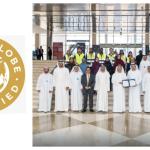Every year, GITEX gathers technology leaders, AI experts, energy specialists, and policymakers to explore how the digital world is being rebuilt around data and computation.
At GITEX 2025, the spotlight is firmly on AI-ready data centers , cloud architecture , quantum computing , and green infrastructure — all crucial to powering the next wave of artificial intelligence and digital innovation.
Dedicated tracks such as Super Data Centres x GITEX GLOBAL highlight the “AI Data Paradox,” focusing on the relationship between energy, privacy, and compute power. Exhibitors include industry giants like Huawei, Vertiv, and Giga Computing, all demonstrating advanced technologies that push the boundaries of scalability, efficiency, and sustainability.
1. The Rise of AI-Optimized Data Centers
Traditional data centers were designed for storage and transactional workloads. But today, the explosion of AI requires a new breed of infrastructure optimized for parallel processing , high-density GPU clusters , and massive throughput .
Companies exhibiting at GITEX are introducing solutions designed for AI workloads — featuring high-density compute nodes, AI accelerators, and architectures that can efficiently handle complex models and training data. These innovations ensure faster processing speeds while keeping energy consumption in check.
The shift toward AI-native infrastructure marks a turning point. Data centers are no longer just warehouses of servers; they are intelligent ecosystems that learn, adapt, and optimize themselves through AI-driven management tools.
2. Power and Cooling: The Core of Future Readiness
As compute density rises, so does the energy demand. AI workloads consume enormous amounts of power, creating challenges in both energy supply and heat management.
At GITEX, energy efficiency has taken center stage. With the UAE’s commitment to sustainable energy — including clean solar and nuclear power — the region is strategically positioned to support global data infrastructure expansion.
Innovations in cooling systems are also redefining operational standards. Advanced liquid cooling, immersion cooling, and modular heat exchangers are being deployed to reduce the power usage effectiveness (PUE) ratio. These technologies help balance performance and environmental responsibility — ensuring that data centers grow sustainably without compromising the planet.
3. Modular and Prefabricated Infrastructure
Another major theme highlighted at GITEX is speed of deployment . As demand for AI capacity grows, the industry is shifting toward modular, prefabricated infrastructure.
These next-generation data centers can be built faster, deployed anywhere, and scaled on demand — cutting down setup time from months to weeks.
This modular approach not only accelerates expansion but also enhances flexibility. Whether serving edge computing needs or large-scale AI workloads, modular systems provide the agility required to adapt to new business or technical requirements quickly.
4. Sustainability as a Central Pillar
Sustainability is no longer a nice-to-have — it’s now the foundation of modern infrastructure. Every keynote, showcase, and panel discussion at GITEX reflects this shift.
As data centers expand, they must do so responsibly. The event’s focus on green data center technologies emphasizes renewable energy integration, efficient cooling, and carbon footprint reduction.
The UAE’s leadership in renewable energy — combined with private sector innovation — positions Dubai as a global example of sustainable technology development. Initiatives showcased at GITEX demonstrate how the region is investing in eco-efficient AI infrastructure that balances performance with environmental responsibility.
5. The Hyperscale Boom
The rise of AI has created a surge in demand for hyperscale data centers — facilities capable of supporting massive, cloud-scale workloads.
At GITEX, conversations about hyperscale development highlight both the opportunities and challenges of this rapid growth. Countries in the Middle East, including the UAE and Saudi Arabia, are attracting significant foreign investment to build these facilities, leveraging their energy advantages and strategic global positioning.
GITEX acts as a bridge between governments, infrastructure developers, and investors, encouraging collaborations that will define where and how these massive data hubs are built.
6. Balancing Privacy, Governance, and Compute Power
One of the most critical discussions at GITEX revolves around the balance between AI compute expansion and data governance .
As nations and companies race to build powerful AI systems, issues of privacy, security, and sovereignty are becoming more pressing.
The “AI Data Paradox” captures this dilemma — how to grow compute power while safeguarding sensitive data and respecting energy constraints.
Through panels, expert talks, and research presentations, GITEX encourages the creation of ethical frameworks and governance models that align with global standards while fostering innovation.
7. The Shift Toward Edge and Distributed Computing
Not all workloads belong in massive centralized data centers. With the rise of IoT and real-time analytics, edge computing is becoming essential.
GITEX highlights the importance of distributed architectures — smaller, localized data centers that bring computation closer to users.
This reduces latency, improves responsiveness, and enables real-time AI applications in fields like autonomous vehicles, healthcare, and industrial automation.
The combination of hyperscale and edge systems represents the future of data infrastructure: globally connected, locally responsive, and infinitely scalable.
8. The UAE’s Growing Role in Global AI Infrastructure
The UAE is emerging as a global leader in AI and data infrastructure, thanks to a combination of policy vision, energy resources, and innovation ecosystems.
Dubai’s energy surplus and its investment in clean power allow the nation to expand infrastructure sustainably.
Government-backed initiatives support public-private partnerships, accelerating the creation of AI-ready data campuses and innovation clusters.
By using platforms like GITEX to attract investors, researchers, and entrepreneurs, the UAE is positioning itself as the center of a new global digital economy — where data is not just stored but actively harnessed to drive innovation.
9. The Challenges That Remain
While the progress showcased at GITEX is remarkable, the path ahead is not without challenges.
Energy consumption remains a critical issue. Even with clean energy sources, managing the growing demand from AI applications requires constant innovation in efficiency.
Cooling remains one of the biggest cost and energy factors. As density increases, cooling technologies must evolve rapidly to avoid performance bottlenecks.
There’s also the question of regulation — ensuring that rapid infrastructure growth aligns with global data protection laws and sustainability goals.
Finally, access to hardware, skilled labor, and supply chain stability continues to be a global concern as the industry scales.
10. Looking Ahead: The Next 5–10 Years
Based on the trends emerging from GITEX, the next decade of AI infrastructure will likely be defined by the following developments:
- AI-Native Data Centers – Facilities built from the ground up for AI workloads, featuring dense GPU clusters, specialized networking, and smart power management.
- Distributed Infrastructure – A blend of hyperscale and edge centers connected through high-speed, low-latency networks.
- Green Energy Integration – Expansion of renewable and clean energy sources to power AI growth responsibly.
- Automation & Orchestration – Data centers will increasingly manage themselves through AI-driven monitoring, fault detection, and predictive maintenance.
- Regulatory Evolution – Stronger frameworks for data privacy, sustainability, and energy efficiency.
- Quantum and Photonic Integration – As new compute paradigms mature, they will begin to integrate with AI infrastructure for higher performance and lower energy use.
These trends point to a future where AI infrastructure becomes not just faster, but also cleaner, smarter, and more distributed — supporting a digital ecosystem that extends across continents.
11. Collaboration as the Foundation for Growth
Perhaps the greatest takeaway from GITEX is that building the future of AI infrastructure is not a solo mission .
Governments, technology providers, investors, and sustainability experts must work hand in hand.
GITEX provides that platform — connecting the right people to design systems that are resilient, sustainable, and scalable.
This spirit of collaboration ensures that progress in AI and data centers benefits not just specific industries or regions, but the entire global technology ecosystem.
Conclusion
GITEX GLOBAL is redefining how the world approaches data infrastructure. Through innovation showcases, high-level discussions, and groundbreaking collaborations, it’s setting the stage for the next chapter of digital transformation.
From hyperscale data campuses to intelligent cooling systems, from AI-ready hardware to green power strategies — every aspect of infrastructure is being reimagined.
The event’s focus on AI, sustainability, and energy efficiency positions it as a global catalyst for change.
As AI continues to evolve, the world will increasingly look to events like GITEX for direction, inspiration, and collaboration.
The message is clear: the future of AI depends on the infrastructure we build today — and GITEX is where that future is being designed.










